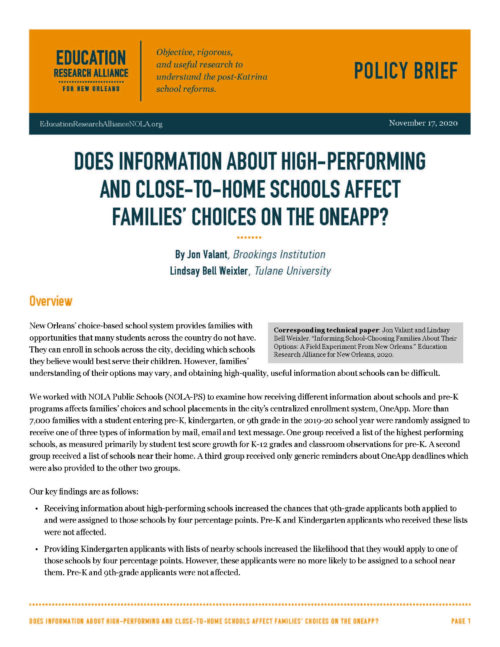Does Information About High-Performing and Close-to-Home Schools Affect Families' Choices on the OneApp?
A new study by Jon Valant and Lindsay Bell Weixler finds that receiving information about high-performing and close-to-home schools increased the likelihood that families would request a seat at one of those schools.

Does Information About High-Performing and Close-to-Home Schools Affect Families' Choices on the OneApp?
Published
by Jon Valant, Lindsay Bell Weixler
Families in New Orleans, where almost all publicly funded schools are charters, have the choice to enroll in schools across the city. To do so, they must rank their top choices using a centralized enrollment system, the OneApp. However, finding high-quality, useful information about local schools and pre‑K programs can be difficult and time consuming. Researchers Jon Valant and Lindsay Bell Weixler worked with NOLA Public Schools to help identify what kinds of information may be useful for families deciding where to apply to school. They find that receiving information about high-performing and close-to-home schools increased the likelihood that families would request a seat at one of those schools. The effects of receiving information about high-performing schools were strongest for families of high school students and children with disabilities. The researchers mailed, texted, and emailed information to over 7,000 families with a child entering pre‑K, kindergarten, or 9th grade this school year. Some families got a list of high-performing schools in their area, as measured by student test score growth for K‑12 schools and classroom observation scores for pre‑K. Others received a list of schools close to home. The key findings are: Receiving information about high-performing schools increased the chances that 9th-grade applicants both applied to and were assigned to those schools by four percentage points. Pre‑K and Kindergarten applicants who received these lists were not affected. Providing Kindergarten applicants with lists of nearby schools increased the likelihood that they would apply to one of those schools by four percentage points. However, these applicants were no more likely to be assigned to a school near them. Pre‑K and 9th grade applicants were not affected. * Students with disabilities were 13 percentage points more likely to apply to a high-performing school when they received a list of those schools and seven percentage points more likely to be placed in one. This study fits into a growing body of research that explores the resources and support that families need in school systems centered on choice. Choice-based systems often pose heightened challenges for families – not only finding relevant and up-to-date information in a dynamic landscape of schools, but also completing multi-step application processes and securing safe and reliable transportation to school. These challenges are especially hard on the most disadvantaged families. Providing useful, relevant information about schools should be part of a larger strategy to help families effectively exercise their role as decision makers in a choice-based system.
Related Publications
Will the Arts Come Marching In? Access to Arts Education in Post-Katrina New Orleans
Sep 15, 2020 | by Sarah Woodward
Do Charter Schools Keep Their Best Teachers and Improve Quality? Retention and Rewards for Teachers in New Orleans
Mar 9, 2020 | by Nathan Barrett, Deven Carlson, Douglas N. Harris, Jane Arnold Lincove
How is New Orleans School Performance Evolving, and Why?
Aug 20, 2019 | by Douglas N. Harris, Lihan Liu, Alica Gerry, Paula Arce-Trigatti

